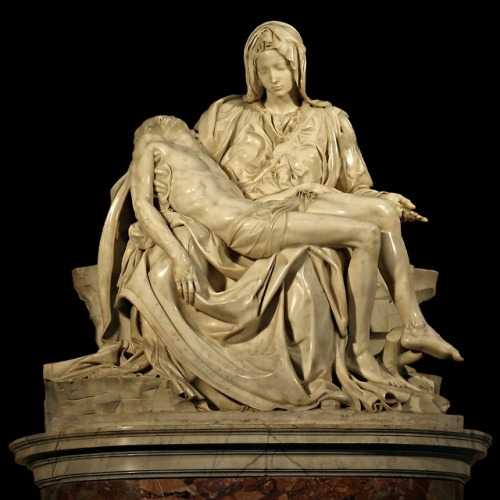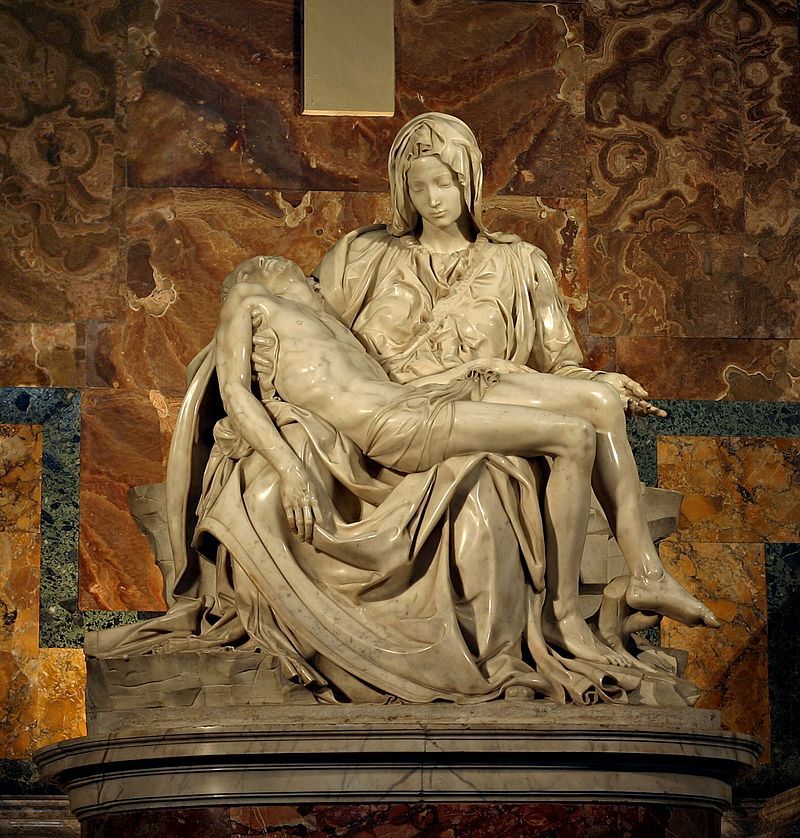Things You Should Know About
Michelangelo's Pietà

BY Kristy Puchko - May 11, 2015
Michelangelo's Pietà

BY Kristy Puchko - May 11, 2015

Since its creation in 1499, Michelangelo's Pietà has inspired emotion, faith, and imitation through its elegant depiction of the Virgin Mary and Jesus Christ. Yet few know the secrets that are still being uncovered about this centuries-old statue.
1. A French cardinal commissioned it for his own funeral.
French cardinal Jean de Billheres, who served the church in Rome, wanted to be remembered long after he'd died. To achieve this goal, he hired Michelangelo to make a memorial for his tomb that would capture a scene that was popular in Northern European art at the time: the tragic moment of the Virgin Mary taking Jesus down from the cross.
Actually, that undersells de Billheres’s request. Michelangelo's exact job description for the project was to create "the most beautiful work of marble in Rome, one that no living artist could better." While other sculptors might have balked at such an intense demand, Michelangelo was confident he could complete such a task. The Pietà is considered by many to be his greatest work, besting even David and the ceiling of the Sistine Chapel.
2. After more than 200 years, the Pietà was moved to St. Peter's Basilica.
The Late Renaissance church houses the religious monument within the first chapel to the right of its entrance. There, countless Vatican City tourists have viewed it. You can visit it virtually here.
3. Michelangelo carved it from a single slab of marble.
Specifically, he used Carrara marble, a white and blue stone named for the Italian region where it is mined. It's been a favorite medium of sculptors since the days of Ancient Rome.
4. Pietà is the only work Michelangelo every signed.
If you look closely, the sculptor’s signature can be found across Mary's chest. Sixteenth century art historian Giorgi Vasari told the tale of how Michelangelo made his mark:
One day Michelagnolo [sic], entering the place where it was set up, found there a great number of strangers from Lombardy, who were praising it highly, and one of them asked one of the others who had done it, and he answered, 'Our Gobbo from Milan.' Michelagnolo stood silent, but thought it something strange that his labors should be attributed to another; and one night he shut himself in there, and, having brought a little light and his chisels, carved his name upon it.
Michelangelo later regretted the vanity of this act, and resolved never to sign another piece of his work.
5. The piece made Michelangelo famous when he was only 24.
Thanks in part to putting his name in plain sight on the Pietà, Michelangelo's reputation grew as the public's love of the statue did. The artist lived to the age of 88, enjoying decades of acclaim and appreciation for his works.
6. The sculpture has been criticized for Michelangelo's depiction of Mary.
Some church observers sneered that the artist made her look too youthful to have a son who was 33 years old, as Jesus was believed to be at his death. Michelangelo defended this choice to his biographer Ascanio Condivi:
Do you not know that chaste women stay fresh much more than those who are not chaste? How much more in the case of the Virgin, who had never experienced the least lascivious desire that might change her body?
7. It’s a mash-up of sculpting styles.
Michelangelo has long been praised for marrying Renaissance ideals of classical beauty with poses that favored naturalism. Another nod to Renaissance influence is a structure that ultimately resembles a pyramid, formed by Mary's head, flowing down her arms and to the bottoms of her robes.
8. Mary's robes hide a creative compromise.
If you look closely, you can see that Mary's head is a bit too small for her very large body. When designing Mary's measurements, Michelangelo could not impose realistic proportions and have her cradle her adult son as he envisioned. So, he had to make her - the statue's support - oversized. To play down this poetic license on her form, Michelangelo carved out sheets of gentle draping garments, camouflaging Mary's true fullness.
9. The Pietà was brutally attacked.
Michelangelo had a habit of shouting at his sculptures and even occasionally lashing out at them with his tools. But it was an unemployed geologist from Hungary who won infamy on Pentecost Sunday of 1972 by leaping over the railings at St. Peter's Basilica to attack the Pietà with a hammer. With 12 blows, Laszlo Toth knocked off Mary's left arm, snapped off the tip of her nose, and damaged her cheek and left eye.
10. Its destruction was not deemed a criminal offense.
The authorities chose not to criminally prosecute Toth for his destruction of the priceless work of art. However, a Rome court deemed him "a socially dangerous person," and committed the man to a mental hospital for two years. After he was released, Toth was deported.
11. Its restoration was a matter of debate.
When a work of art is damaged in this way, its exhibitors are forced to debate what's best—leaving it as it is (like Cleveland's The Thinker that was mangled in a bombing) or altering the original to restore it. The Vatican heard three arguments on this matter.
The first declared that the Pietà's damage was now a part of its meaning, speaking to the violence of our modern age. Others proposed that the sculpture be repaired, but with visible seams as a reminder of this grave assault. Ultimately, a seamless restoration was chosen, with the goal of making it impossible for observers to know that Toth had even touched Michelangelo's masterpiece.
12. THE RESTORATION TOOK 10 MONTHS.
Master craftsmen picked through the 100 bits of marble broken off of the Pietà and puzzled them back together. In a makeshift lab built around the statue, these workers spent five months identifying pieces as small as fingernails. Next, they used an invisible glue and marble powder to affix the pieces back onto the Pietà and filled any gaps with replacement pieces. And once the integral restoration was completed, the final step was securing the restored work behind bulletproof glass.
13. This was not the first time it was behind bulletproof glass.
In 1964, the Vatican loaned the Pietà to the United States, where it was displayed as part of the 1964 New York World's Fair. To ensure the safety of this statue, organizers erected a barrier of seven massive sheets of plexiglass that collectively weighed more than 4900 pounds. Then, to make sure crowds would safely pass by the sculpture, conveyor belt-style mobile walkways were installed.
14. The Pietà's attack had an unexpected silver lining.
During its diligent restoration, workers discovered a secret signature on the piece. Hidden in the folds of Mary's left hand was a subtle "M" believed to stand for Michelangelo.
15. Michelangelo’s Model for The Pietà may have been discovered.
In November 2010, American art historian Roy Doliner claimed that a restored 12-inch statue from the late 15th century is a long-misidentified Michelangelo piece that served as the test run for his Pietà. The small sculpture of Mary and Jesus was previously attributed to celebrated 15th century sculptor Andrea Bregno. But Doliner believes this piece was a sort of proof of concept given to cardinal de Billheres to secure the commission.

http://mentalfloss.com/article/63602/15-things-you-should-know-about-michelangelos-pieta

The Pietà (Italian: [pjeˈta]; English: "The Pity"; 1498–1499) is a work of Renaissance sculpture by Michelangelo Buonarroti, housed in St. Peter's Basilica, Vatican City. It is the first of a number of works of the same theme by the artist. The statue was commissioned for the French Cardinal Jean de Bilhères, who was a representative in Rome. The sculpture, in Carrara marble,
was made for the cardinal's funeral monument, but was moved to its
current location, the first chapel on the right as one enters the
basilica, in the 18th century. It is the only piece Michelangelo ever
signed.
This famous work of art depicts the body of Jesus on the lap of his mother Mary after the Crucifixion. The theme is of Northern origin. Michelangelo's interpretation of the Pietà is unprecedented in Italian sculpture. It is an important work as it balances the Renaissance ideals of classical beauty with naturalism.






No comments:
Post a Comment